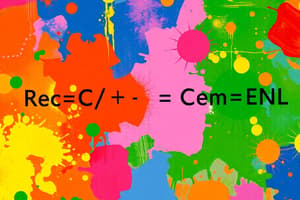Podcast
Questions and Answers
Which representation of a chemical reaction uses only words?
Which representation of a chemical reaction uses only words?
- Chemical equations
- Subscripts
- Picture equations
- Word equations (correct)
In a chemical equation, what do coefficients indicate?
In a chemical equation, what do coefficients indicate?
- The number of molecules involved in the reaction (correct)
- The type of molecules involved
- The states of matter for reactants and products
- The number of atoms in each element
What is the primary principle stated by the law of conservation of mass?
What is the primary principle stated by the law of conservation of mass?
- Matter can be destroyed and recreated
- Matter can be created but not destroyed
- Matter can change forms but remains the same in amount
- Matter can only be rearranged in a closed system (correct)
At what level of representation do we visualize what molecules look like using diagrams?
At what level of representation do we visualize what molecules look like using diagrams?
Which component of a chemical formula indicates the number of atoms of that element in a molecule?
Which component of a chemical formula indicates the number of atoms of that element in a molecule?
What term describes the arrangement of electrons in an atom?
What term describes the arrangement of electrons in an atom?
Which statement about energy levels is correct?
Which statement about energy levels is correct?
What is the maximum number of electrons that the second energy level can hold?
What is the maximum number of electrons that the second energy level can hold?
Which of the following best describes sublevels within energy levels?
Which of the following best describes sublevels within energy levels?
Why do electrons in an atom tend to fill the innermost shells first?
Why do electrons in an atom tend to fill the innermost shells first?
What is the principle quantum number for the first energy level?
What is the principle quantum number for the first energy level?
How are electrons distributed within an atom?
How are electrons distributed within an atom?
What shape and orientation are associate with the 's' orbital?
What shape and orientation are associate with the 's' orbital?
Flashcards
Chemical Reaction
Chemical Reaction
The rearrangement of atoms, forming new compounds.
Macroscopic Level (Reactions)
Macroscopic Level (Reactions)
Observing changes in a reaction using your senses, like color change.
Microscopic Level (Reactions)
Microscopic Level (Reactions)
Visualizing molecules in a reaction using diagrams.
Submicroscopic Level (Reactions)
Submicroscopic Level (Reactions)
Signup and view all the flashcards
Word Equation
Word Equation
Signup and view all the flashcards
Reactants
Reactants
Signup and view all the flashcards
Products
Products
Signup and view all the flashcards
Picture Equation
Picture Equation
Signup and view all the flashcards
Chemical Equation
Chemical Equation
Signup and view all the flashcards
Coefficients
Coefficients
Signup and view all the flashcards
Subscripts
Subscripts
Signup and view all the flashcards
Law of Conservation of Mass
Law of Conservation of Mass
Signup and view all the flashcards
Electron Configuration
Electron Configuration
Signup and view all the flashcards
Electron Shells
Electron Shells
Signup and view all the flashcards
Sublevels (orbitals)
Sublevels (orbitals)
Signup and view all the flashcards
Maximum Electron Capacity
Maximum Electron Capacity
Signup and view all the flashcards
Energy Levels
Energy Levels
Signup and view all the flashcards
Study Notes
Chemical Reactions
- Chemical reactions are the rearrangement of atoms, resulting in the formation of new compounds.
- There are 3 levels to consider when looking at chemical reactions:
- Macroscopic: This involves observing changes using our senses; for example, observing the color change when iron rusts.
- Microscopic: This involves imagining what the molecules look like using ball diagrams or illustrations.
- Submicroscopic: This involves using symbols from the periodic table to represent the elements and compounds involved in the chemical reaction.
Representing Chemical Reactions
- Word Equations: Express chemical reactions using words, for example, hydrogen + oxygen → water.
- Reactants are substances on the left of the arrow.
- Products are substances on the right of the arrow.
- Picture Equations: Represent chemical reactions using illustrations of atoms and molecules.
- Chemical Equations: Use chemical formulas and symbols representing elements and compounds, for example, 2H₂ + O₂ → 2H₂O.
- Coefficients: The numbers in front of the chemical formulas indicating the number of molecules involved in a chemical reaction.
- Subscripts: Small numbers below and to the right of a chemical symbol that indicate the number of atoms of that element in a molecule.
The Law of Conservation of Mass
- The law states that in a closed system, matter cannot be created or destroyed; it can only be rearranged.
Key Points
- Chemical reactions are a key part of chemistry, playing a crucial role in natural phenomena and in many industrial processes.
- Understanding the different levels of representation is critical for effectively studying and describing chemical reactions.
- Always remember to balance chemical equations to ensure that the number of atoms of each element is the same on both sides of the equation.
Studying That Suits You
Use AI to generate personalized quizzes and flashcards to suit your learning preferences.




